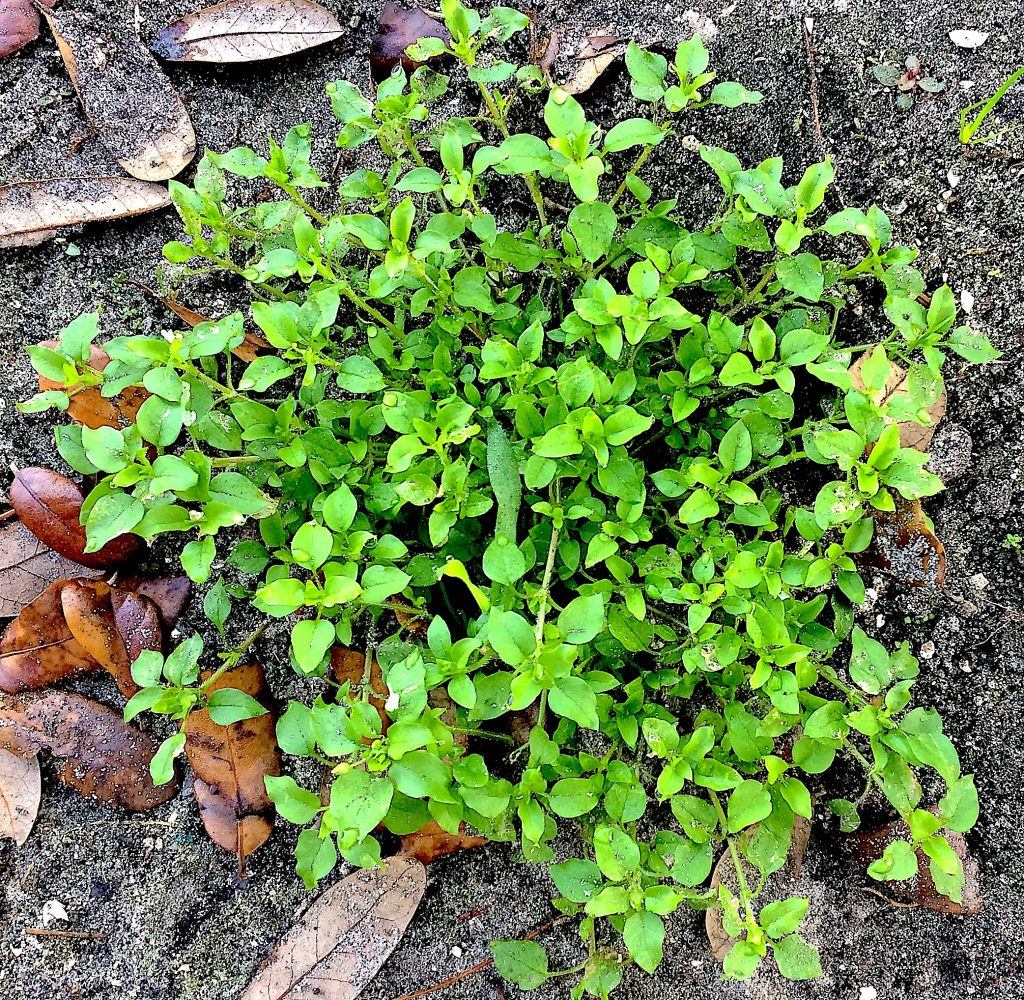
Chickweed Thrives in Cooler Weather. Photo by Green Deane
Chickweed Connoisseurs
You never know where you’ll find Chickweed but locally you know when: Winter. When I owned a lawn it showed up gloriously every December. (If you live up north, think soon after the snow goes.)
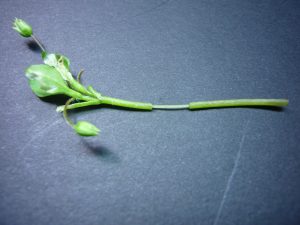
Chickweed has a stretchy inner core. Photo by Green Deane
Of course, few lawn owners view Chickweed as glorious. Decapitated grass has given chickweed a bad rap. Instead of lawn lovers pulling out a clump of chickweed and having it for dinner, they spend a lot of green to get rid of the green. Killing chickweed is a million-dollar business which is a large expense and a waste of food.
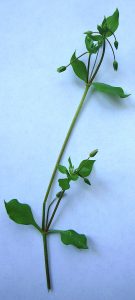
Chickweed has a side-shifting single line of hair down the stem.
Chickweed tastes good and is good for you with ascorbic-acid, beta-carotene, calcium, magnesium, niacin, potassium, riboflavin, selenium, thiamin, zinc, copper, and Gamma-linolenic-acid. That’s a win win as they used to say. Raw, it tastes exactly like corn silk, if you’ve ever tried that. Cooked it is similar to spinach though the texture is different. It can be added to soups or stews but in the last five minutes to prevent overcooking. Unlike many wild edibles, the chickweed’s stems, leaves, flowers and seeds are all edible. It does hold nitrates and people with allergies to daisies might want to pass it by. Only the Mouse-Ear chickweed should be cooked because of texture issues. The rest of the Chickweeds can be eaten raw but I think they tastes better cooked.
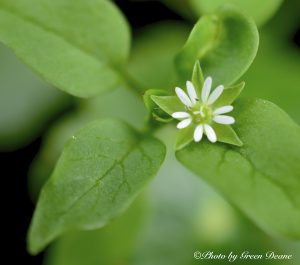
The incised five-petaled blossom looks like ten petals. Photo by Green Deane
The species scientific name is Stellaria media (Stel-LAY-ree-uh MEED-ee-uh which means “little star in the mist.” Probably from Eurasia, it is now found around the world even in the arctic circle and Greenland (as are thistles, mustards, clover, and blackberries.) Chickweed is also a back yard barometer. Its leaves fold up when it’s going to rain. The leaves also fold up at night. Cute. Also, chickweed is not an early riser: The blossoms open late in the morning. And it’s called chickweed because chickens love it. There are some reasonably close look-alikes, but three things separates chickweed from poisonous pretenders. First, it does not have milky sap. Next, it has one line of hairs on its stem that changes sides at each pair of leaves. And if you bend or crease the stem, rotate each end counter with each other, and pull gently the outer part of the stem will separated but the elastic inner part will not and you will have a stretched inner part between the two stem ends. See picture above right.
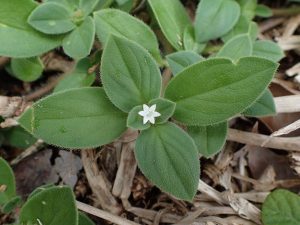
Richardia scabra is mistaken for Chickweed.
If you have chickweed but it doesn’t quite fit the description, look at my article on Drymaria coradata, a Chickweed cousin that shares some characteristics. A second plant that is commonly mistaken for Chickweed is Richardia scabra. That always surprises me as Richarda is rougher and ranker. Folks get thrown off by the species’ blossom. Richardia is generally consider not edible and at least one species will make you throw up, Richardia emetica (also called Richardia brasiliensis.) Can you eat R. scabra? I know some people who have mistakenly done so. They didn’t eat a lot of it but none reported any immediate ill effects.
Chickweed Bread
2 cups of chopped chickweed leaves and stems.
¼ cup minced onion
2 tablespoons oil
2 tablespoons honey, fruit juice concentrate, or sugar
1 teaspoon salt
3 cups wheat flour
¾ cup warm water
1 packet yeast
Sauté onion and chickweed until tender (not brown). Dissolve honey and yeast into the warm water and then the salt. Mix the yeast mixture with the cooled sautéed chickweed and onions and slowly add the flour until the dough no longer sticks to your fingers Form into a ball and let it rise to twice its volume. Shape into loaves and let rise again. Bake at 375 .F for 40-45 minutes.
Chickweed And Bacon Pie is best hot; it will keep one to two days in the refrigerator and can be reheated.
One 10-inch pie crust
3 cups chopped chickweed
1 cup diced slab bacon
½ cup finely chopped onion
3 large eggs
1½ cups sour cream
1 tablespoon all-purpose flour
½ teaspoon grated nutmeg
Preheat oven to 325 degrees. Line a 10-inch pie dish with crust and make a raised border around the rim to prevent filling from overflowing during baking.
To prepare chickweed, remove all leaves, twigs and root ends, reserving only the greenest, leafiest parts. Rinse thoroughly in a colander and gently dry with paper towels. Bunch the chickweed together into a ball and chop it with a sharp knife until reduced to a confetti texture. Measure, then put chickweed in a large bowl.
Fry diced bacon in a skillet until it begins to brown, then add onion. Cook about 3 minutes, or until onion wilts. Using a slotted spoon, transfer bacon and onions to bowl with chickweed. Discard drippings from pan.
In a separate bowl, beat eggs until lemon colored, then add sour cream, flour and nutmeg. Add egg mixture to chickweed, onions and bacon. Spread filling evenly in the pie shell and pat down firmly with a spoon. Bake 45 to 50 minutes, or until pie has set in center and top looks golden.
—Adapted from Pennsylvania Dutch Country Cooking by William Woys Weaver (Abbeville Press, 1993).
Green Deane’s “Itemized” Plant Profile
IDENTIFICATION:
Annual herb with slender, smooth stems to about a foot long, one row of tiny hairs growing in a row on one side of the stem, switching to other side at each pair of opposite, oval pointed leaves. Old leaves have stalks, young leaves do not. Flowers, small, white with five petals so deeply notched that they look like ten petals. Does NOT have milky sap. If you have a plant you think is chickweed and it has milky sap you have the wrong plant.
TIME OF YEAR:
During the cool weather of spring, which in Florida is February. Dislike heat, germinates in the winter.
ENVIRONMENT:
Likes moist soil and or shady areas.
METHOD OF PREPARATION:
Numerous, usually chopped and boiled or fried, or added raw to salad. Chickweed can be stringy so it is often chopped. Has many herbal uses, too numerous to mention.
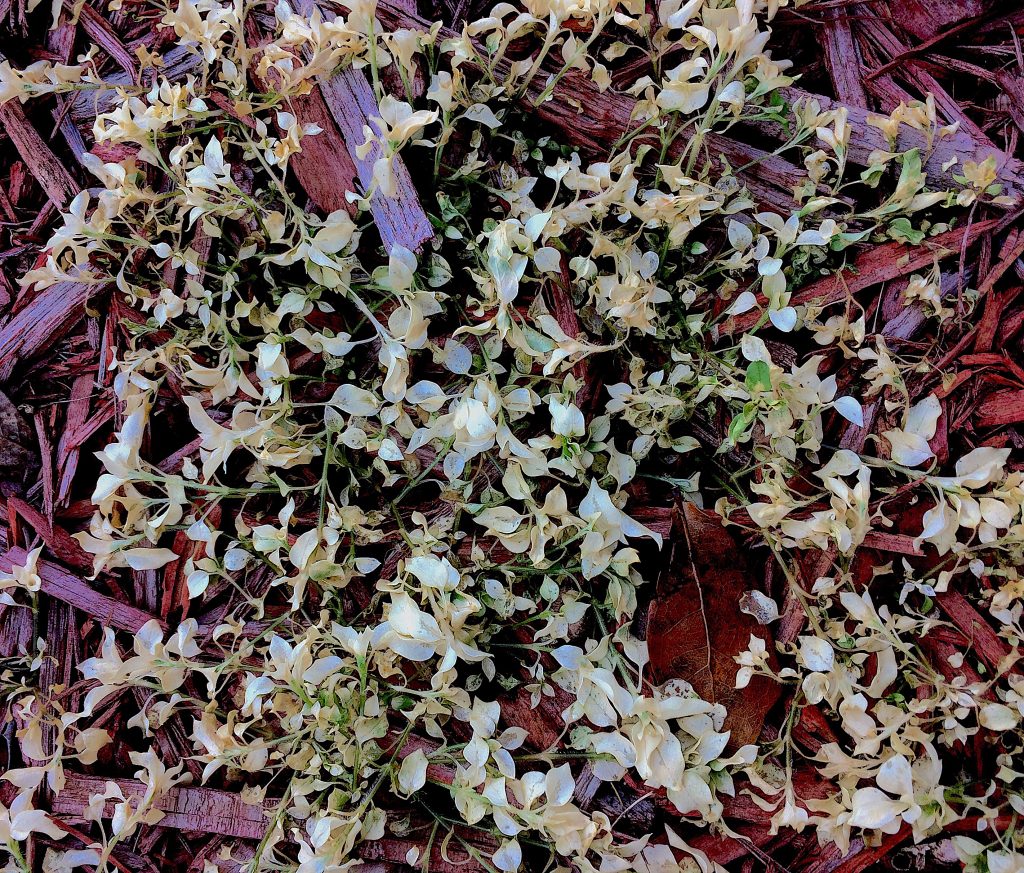
Chickweed in mulch going out of season. Photo by Green Deane


Is the level of nitrates dangerous in this herb?
I’ve never heard of this plant collecting nitrates.
The article above says it does hold nitrates. I’m confused.
The plant has higher nitrates than other plants. Some people have to have a low-nitrate diet.
great stuff,makes great wild salad with some henbit and peppergrass and dandelion flowers…got anymore recipes for chickweed?
Thank you, thanks to your itemized profile I will be adding a patch of chickweed to the soup I am just about to make!
I found a plant that is a close look alike to chickweed in the garden. It has about the right size/height and the leafs were opposite and appeared the correct shape.
Thanks to your ITEMIZE the square stalk ruled it as something different. also the lack of alternating hairline. Still not sure if it is Anagallis monelli or Anagallis arvensis. The flowers are blue and form in pairs above the leaves, their arrangement has them appear as if the flowers are in hugging position.
When it first appeared in the garden, it looked very presentable so I let it be. A very hardy plant and has done well into the current heat of summer. Although the heat has started to get the best of it and is about to go to seed.
I am finding little information in the about these, and would like to know the origins, and which portions are edible if any?
As far as I know Anagallis are not edible.
Ok,
Elastic inner core check,
Leave placement check,
10 petaled white flower check,
Tastes simil. to cornsilk check,
No milk check,
Looks like every chickweed pic. I see,
However the stems and leaves are covered in hair no single row is evident.
Let’s try Cerastium vulgatum, Mouse ear chickweed. Couplan says on page 107 of his Encyclopedia of edible plants of North America that young plants are edible. They are picked before they bloom.
Stellaria or chickweed have a soft and moist soapy texture in their leaves. while cerastium is very hairy. Once you learn how to spot their difference, it is rather easy. Their flowers are rather similar, white, small, numerous and 10 petals.
Stellaria grows often as a weed, as a carpet, in fertile cultivated soils.
Do or can you eat the whole plant including the small flowers from chickweed Thanks
All the above-ground parts of the plant are edible.
It may be a good idea to reference scarlet pimpernel as a look alike. They appear very similar if there are no flowers present. Make sure people know to avoid tiny purplish spots on the undersides of the leaves and a square stem that definitely does not pull apart as you mentioned.
Thank you! I was able to find the tiny hairs on my chickweed, and the stem pulled apart just like the picture.
I’m impressed!
After conferming that I’ve the correct identity of this plant ( please see my comment in Eattheweeds issue 19Nov.2013) I’ve cooked the following per one person: good mixing of : one handful of the plant well washed with hot water and carefully sliced; one medium size tomato cut into small slices; about fifty grams of non salty cheese; one egg; garlic, coriander, black pepper, cinnamon and salt. After thorough mixing fry with sun flower -vegetable- oil for three to five minutes .
I am sooo excited …I found and identified chickweed. my first wild edible. !!!!! I have been trying for sooo long to do this. I stir fried it with some green onions and butter and oil. then added lemon. It was amazing!!!! tasted just like spinach. I have a lot of it in my yard and I am going out in the morning searching for more to freeze. I can’t thank you enough for being so precise on your identification. I feel at ease because I couldn’t find anyone around the area to help me. I live in N. Charleston, SC.
Why does mouse ear chickweed have to be cooked?
It’s hairy texture is moderated by cooking.
Hi, I have some plants on my yard that look similar to chickweed. Is there any way that I can send you a picture so you can tell me if those are really a chickweed. Thank you very much!
Yes, and where are you? You can post them on the Green Deane Forum UFO page (unidentified flowering objects.)
Hi,
I’m writing a piece on Chickweed this week for my blog, do you mind if I link to this? I like the idea of Chickweed Pie….
Thanks
Vivienne
You may link to it.
I just discovered your website while searching Google for “chickweed identification”, and I’m hooked! Thanks for all the great info. I’ll be bookmarking your site and reading every article. I’m also excited to say, after reading this article, I know for certain I have almost a full acre of chickweed, plus about 10X10 feet of it inside my garden on the fallow side! I’m completely stoked about this–after 4 years working this rocky, dry land, I’m finally seeing some really interesting things popping up <3
I would think “media” in the name Stellaria Media would refer to the inner cord inside the stem. I can not figure out how it would mean “in the mist” maybe “in the midst” but that still seems confusing. I think media in English is borrowed directly from the Latin.
Do you know if the edible type chickweed grows in S E Arizona, or if I buy seeds it will naturalize?
I have some chickweed growing in a pot with my grapefruit tree. Keeping it pruned and at a constant indoor temperature has kept in alive for 3 years, constantly regrowing. My old cockatiel loved eating chickweed I’d pick from the garden in spring.
Up here in northern Illinois, different varieties of this stuff are everywhere (not right now though, of course). There’s a somewhat larger leafed, delicate rambling variety by our creek that’s very tasty. A smaller leafed one, also tasty, is all through the lawns at a local park and pretty much anywhere that doesn’t use herbicides. And some fuzzy, mat-forming mouse-eared chickweed is a welcome, self-appointed groundcover in my garden. Love this stuff!
Is this chickweed? I would really love to try some but am new to identifying it. Thanks in advance.
https://photos.app.goo.gl/ShSAhH7XVumRDnh88 is this chickweed? I’m new to identifying it but would love to try it. Thanks in advance.
No, that is a Richardia. It’s a common mistake.
I am always so thrilled with the abundance that our Creator YHWH has given us. There are so many overlooked plants that we can eat, use for medicine, etc. We have everything we need if only we have the eyes to see.
Hi, does anyone know for certain if Snow in Summer chickweed is edible as well? I love to eat chickweed and thought this variety would look beautiful in the garden. I don’t want to grow it if I might get it mixed up with the chickweed I eat, and shouldn’t eat it.
Thanks!
Perhaps you are referring to Drymaria cordata. I have an article on that species. It is edible.